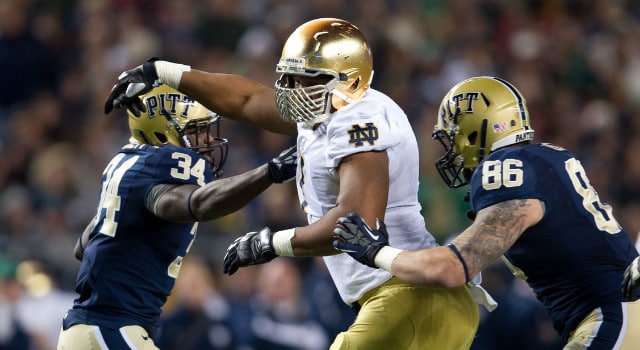

Notre Dame defensive end Stephon Tuitt adamantly pleaded his case with officials in Notre Dame’s game against Pittsburgh as head coach Brian Kelly aided his defense with words of anger from the sideline. The objections were dismissed, and the Fighting Irish star joined a growing statistic of over 50 players ejected due to the NCAA’s new targeting rule.
The grumbling has seen a steady rise throughout the 2013 season with programs from every corner of America taking aim. Ohio State head coach Urban Meyer voiced his opposition to the rule after Buckeye cornerback Bradley Roby was disqualified for a targeting call against Iowa.
“We at Ohio State are very concerned about player safety,” Meyer said. “However, [Roby’s ejection] was a game-changer. To take one of your better players out of the game, that impacted the game.”
In an unexpected twist illustrating how powerful criticism of the new rule has become, the Southeastern Conference put aside its contentious past with Meyer and joined his side after a rash of ejections swept across the SEC’s borders. Two targeting calls were enforced within Georgia’s match against Vanderbilt, and one a piece in South Carolina’s matchup against Tennessee and Florida’s contest against Missouri. Georgia was particularly incensed after a targeting foul was called against Bulldog linebacker Ramik Wilson. Though Wilson’s disqualification was overturned, the 15-yard penalty still stood, highlighting a peculiar component of the targeting rule: a player can be found innocent of targeting upon instant replay review yet the 15-yard penalty remains. The extra yardage breathed new life into a Vanderbilt Commodore team that trailed 27-21 at the time of the occurence. Vanderbilt would ultimately come from behind and upset the Georgia Bulldogs, 31-27.
The ascending tidal wave of discontent is on the verge of crescendo with media personalities supplementing head coaches and football conferences in their quest to bring about the rule’s downfall. College football analyst Bill King personally lights every villager’s mob torch whenever the targeting rule is mentioned by callers on his weekday program, On Campus. Even Mike Pereira, former Vice President of Officiating for the NFL, has lanced the rule, indignantly writing a column that openly questioned the relevancy of the NCAA.
With such acrimonious contempt stemming from experts of the game, it isn’t hard to imagine how irked fans have become. What is it, exactly, about the rule that has led to such hostility in an era where player safety is paramount?
The NCAA’s Rule 9-1-3 states:
No player shall target and initiate contact against an opponent with the crown (top) of his helmet. When in question, it’s a foul.
The NCAA clarifies its meaning by defining what it makes to “target”:
To take aim at an opponent for purposes of attacking with an apparent intent that goes beyond making a legal tackle or a legal block or playing the ball.
Stephon Tuitt’s hit – and subsequent ejection – on Pittsburgh quarterback Tom Savage brought to the surface every faulty element within the well-intentioned rule. Early in the second quarter Savage scrambled out of the pocket and toward the sideline, and as he did so was met with a helmet-to-helmet collision. Tuitt committed to the tackle, and Savage dropped his shoulder to rightly protect himself, which is when the point of contention surfaced.
The 6’6” Tuitt began the process of the tackle with his helmet at chest height, and it was only when the 6’5” Tom Savage lowered his shoulder to mitigate the ensuing blow that their helmets reached the same level and made contact. The helmet contact was what drew the yellow flag – the question then became whether or not Tuitt targeted the Panthers quarterback.
The test for whether or not a player engaged in targeting consists of actions that denote risk, with one indication of “less risk” being when the contact is “incidental” and is more consistent with “players changing position during the course of the play.” Officials presiding over the incident had to ask themselves one simple question: did Tuitt intend to go beyond the legality of a tackle or was the collision due to Savage lowering his shoulder? Thanks to the rule’s burden of proof, which assumes guilt unless innocence is ultimately proven, the answer was an easy one.
When in doubt, throw ‘em out.
In a smidgen of unfortunate irony, at the end of the third quarter Pittsburgh defensive back Trenton Coles suffered a serious head injury when colliding with teammate Jason Hendricks while attempting to break up a pass intended for Notre Dame wide receiver William Fuller. Given the current state of the NCAA’s targeting rule, an argument can be made the only thing that spared Hendricks from disqualification was the fact his unintended victim shared the same logo on his helmet.
The shortcomings of the NCAA’s targeting rule and its repeated public relations defeats come on the heels of an ESPN Outside the Lines report documenting former Pittsburgh great Tony Dorsett’s diagnosis with a degenerative brain disease, the same disease former Notre Dame great Dave Duerson suffered from prior to his death in 2011.
What can be done to solve the flawed system remains elusive, but the one thing that cannot be denied is that the NCAA is falling behind in a health battle it can ill-afford to lose.
Scott Janssen is a blogger for the Huffington Post and has authored several nationally-featured articles as well as co-founded a nationally-featured non-profit organization. In his spare time he takes his NCAA Football ’13 online dynasty way too seriously and alienates those around him by discussing football 24 hours a day. Scott can be reached at [email protected]
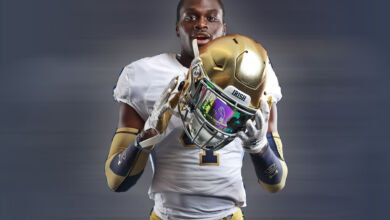
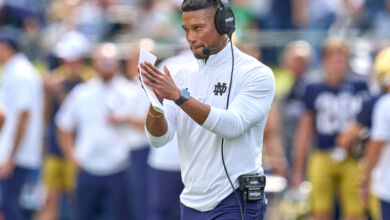
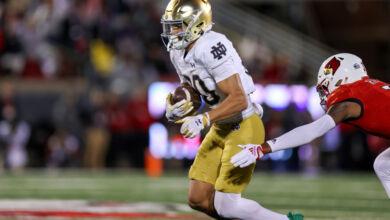
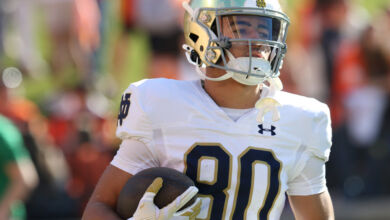
Lets get something straight, IT’S A VIOLENT GAME! You know it the second you put on the pads and step between the lines. I feel bad about the the players mentioned, but if the fact is that you want to end these types of collisions, than you should just take out the pads and put flags on them. The problem I see with players is they want the blow up shot. Most of those shots are high velocity and leading with either your head or shoulder. If you want to stop this teach wrapping up the ball carrier and taking him to the ground and not throwing a shoulder into his chest, knee or other areas. By the way this is how the ND secondary tackles. Hit and wrap, the object is not to dislodge the ball carrier from the ball, but to get them on the ground. This is why you have some many issues with concusions. The only other option is to take away helmets and shoulder pads, you’ll see them stop leading with their head and shoulder or trying to blow people up. However you will increase stiches, dislocated shoulders, broken collar bones and broken ribs.
Like I said it’s a violent sport and once you get past high school and into college ball you should know what you are getting into. Also, they did know what the effects were on players just look at John Mackey and Mike Webseter. Both had issues related to football that were diagnosed in the 90’s. Why do you think the NFL paid out rather than going to court. The targeting rule is fine, but the ejections are a mess.
True, the game was modernized and made less violent in the early 20th c. but it was still very much a manly sport and one with a fair amount of injuries. What the NCAA did was liberalize certain rules, for instance, making the forward pass a part of the game. Football, which had looked a like what we call Rugby, prior to these rules changes modernized and began the process that has led the sport to where it is today. It remains a man’s game and the caliber of athlete makes the game dangerous. So, unless you want computer nerds playing football or you change the rules to such an extent that it’s no longer even a contact sport, then the options are improve equipment and make subtle rules changes. The improved equipment is on its way. As for rule changes, simply eliminate the subjective aspect and make all hits above the shoulders and at the knees illegal, whether or not intent is involved. However, if the player getting hit lowers his head or goes down, or jumps so that contact that would’ve been at the thigh happens on the knees, then there should be no flag. But those movements will be clear to the refs. Defenseless players should continue to be protected as per current rules. Thus, under these proposed rules, Tuitt should not have been flagged since the QB started to slide prior to Tuitt’s hit.
If you know your college football history, then you know
that in it’s early years, college football came very close to being banned all together.
There was overwhelming college administrative, and public outrage, over the extreme level of violence and severe injury rates.
(And this was well before Television and the internet)
So the NCAA was formed, rules were put in place, things like the flying
wedge were disallowed, and the equipment was improved and modified…..
And oh how the dollars rolled in!
We may all well be seeing either the end of football or its evolution into a different game. Who knows? Last time football morphed for reasons of safety at the turn of the 20th c., including allowing for the forward pass, ND greatly benefited from that and was a pioneer in the new style game of football. Perhaps history will repeat itself in the future. Or perhaps football as a sport is doomed because the PC crowd will just kill it outright.
There’s nothing politically correct about player safety. It’s important the NFL and NCAA do something to try to prevent the kinds of brain injuries suffered by Dave Duerson, Junior Seau, Tony Dorsett, etc.
The NCAA rule isn’t correcting the problem. I don’t think anyone would argue that point. But it’s important the NFL and NCAA keep trying, and there’s nothing politically correct about that.
Fine, so let’s just play two-hand touch. Let’s see how the ratings and money for football go then.
Let’s face it. The reason football is so popular is precisely because of the controlled violence. This is what happens when you play a collision sport, people get hurt.
If you don’t think there’s too much PC BS in our society, you haven’t read the headlines about parents suing because there kid doesn’t get a trophy, little leagues that don’t keep score and allow kids to keep on batting until they get a hit (I don’t know about you but those games must be endless!), etc. These people will indeed kill football as we know it.
Scott,
You make a valid point, but I also think you miss the point.
The players you mentioned (Duerson, Seau, Dorsett) have/had one distinct advantage over the everyday college kid who happends to play football, (besided their popularity and professional earnings) the Pro’s have the full backing and support of a rather strong players union.
(Or in other words, someone dedicated to look after their immediate and long term concerns)
The NCAA raked in over $870 million last year and the best they can do is implement a “Targeting” rule?
The only thing that rule did for the NCAA was attempt to pacify an already bamboozled public while ensuring their bottomline profit margins remained at a premium.
For the obscenely huge amounts of money the NCAA makes off a game played by a bunch of unrepresented 18-21 year olds each and every year, compaired to what they give back toward assisting those same 18-21 yr olds who encounter long term health issues because of college football is insulting and could easily lead one to argue the American slang term…. “pimpin ain’t easy”
Not only does it seem to be disturbingly easy, but highly profitable and all power enriching as well.
At Least ND stays committed to the full 4 year scholarship and the priority of graduation AND a earned degree from the University of ND.
They re-invest the income from football back into the university to benefit all students, while placing a premium on player safety, well being, and their overall best interests first and foremost.
But in today’s world that seems to be the exception, not the norm.
Knees are going to start becoming jelly very soon…
msnbc.com – front page
“Costas on kids and football: ‘Tell them no’
“Both a fan and a critic, sportscaster Bob Costas said he would not advise parents to let their children play football, citing the sport’s extreme danger.”
Chess anyone?
Bob Costa is an idiot. Raising a nation of whimps!
Jack,
Unfortunately, Costas indeed has the stage and the future of football is the new negative debate in the media. Further, if it were your son on a stretcher would you be screaming whimp? I love football as much as you do, however, facts are we need a new protective helment fast! Otherwise, attorneys will have their new ambulance chase ad: ‘Has your son been injured in football’? Call us today for a free consultation! Sorry, it has nothing to do with whimps. Injuries are real, one liners won’t make this go away and we won’t like the outcomes either. The impact of the NFL settlement will be far and reaching into all of football.
JC, I agree completely. I am extremely sensitive to what I call the “wussification and feminization of the American male.” And I consider it a scourge on society. I have young sons. However, having a meaningful discussion about football safety does not make one a “wimp”. Talk about a strawman.
I have a good friend whose son is 9. He’s a good athlete and running back of this team. He got a helmet-helmet hit about a month ago and went limp as a ragdoll. His dad, who has a medical background, went onto the field and did the consussion testlist on his own son. The boy’s pupils were pinpoints and he couldn’t move his legs for several minutes.
Thanks be to God, he ended up ok, a mild consussion. Do you know what the running backs coach told my friend after he was taken out of the game for good? He suggested to the father that it really wasn’t a big deal and that the kid should play. I told my buddy, “You’re a better man than I, because that coach would have been picking up his own teeth and bleeding profusely from the mouth, had that been my son.”
It’s a legitimate issue.
When you look at the play, Tuitt lowered his helmet first towards the body of Savage. Savage was the one who then lowered HIS helmet for the helmet to helmet hit and so SAVAGE should have been ejected. How is THAT for a twist !!!
Only the US military has developed new ‘prototype’ helment technology that reduces impact by 30%. Current football helments do not offer protection against mild or severe concussions whatsoever. If new technologically superior helments do not arrive soon (85-95% effectiveness), football is in deep trouble. In a litigious American society one only has to digest what just happen in the NFL. Before and after MRI’s, will definitely dictate just how serious the claims will be on a grander scale now! Attorneys as you know, will haul in everyone involved concerning individual cases, and compensation will be expensive based on this landmark NFL case. Especially, college to grade school cases will certainly esculate with proper MRI medical documentation transparency. Given the current state of healthcare, immediate legal action will become an automatic modus operandi for football. Pray for a new techological helment solution, otherwise, flag football may even be wishful thinking in the next decade. Not to mention, all contact sports will be critically reviewed as well considering the recent NFL settlement. Lastly, the greatest fear down wind MOM will not let her son play football! So the pipeline of football talent dries up. Chess anyone?
You could almost make the case that helmets are too good at this point, thus becoming a weapon. Imagine leather helmets, nobody would dare lead with their head.
The NCAA is a bit more ridiculous than the NFL, but in my opinion, both bodies are addressing player safety concerns incorrectly. Both are penalizing outcomes which are inherent to the system they created. Unless they change the system, they can throw as many flags as they want but outcomes will not change. Since defensive players can’t touch receivers for all intents and purposes, offenses are naturally inclined to throw more. Think about the advantage the offense has…the defender really can’t use contact to slow down or re-route receivers and the receiver knows where they are going. By the way, the rules are like this to promote more offense, because that sells. Combine the offensive bias with the bigger/stronger/faster/PED-S infused athlete of today and there you have it, a lot of violent collisions that result in all sorts of injuries. But rather than address the real issue, rule makers are penalizing inevitable outcomes. In turn, players and coaches have tried to adapt. They spend all kinds of time trying to teach proper technique but it doesn’t seem to be working. Football is a violent game and by and large the more physical team stands a better chance of winning. With that said, I believe the targeting rule actually will lead to more injuries not fewer. This is due to two factors. First, and I have definitely seen this in 2013, after a targeting call is made in a game, defensive players seem to become tentative. This will undoubtedly lead to more injuries. Second,the targeting rule actually serve as a catalyst for more hits on defenseless receivers, not fewer, due to the fact that as a play-caller, it pays to send receivers over the middle. The odds are in favor of a positive outcome for the offense as the chance for a penalty is far greater. Woody Hayes used to say he didn’t like throwing the ball because 2 out of 3 outcomes were negative for the offense (incomplete or interception). Well, the equation has changed dramatically. Remember, to his way of thinking, the defender separating the receiver from the ball with a big hit was part of the incomplete equation. Now that same hit often times results in a penalty, 15 yards, and a first down. Draw your own conclusions. My money is on the deep in being dialed up more and more. Remember back in the ’70s, the highlights of Lynn Swann getting his head handed to him by George Atkinson and Jack Tatum? Do you think Swann was eager to run that route again? Hell no. But now, because of the increased potential for a positive outcome, OC’s call it all day long. The receiver still gets his head caved in from time to time, but that’s ok because in that instance, you get 15 yards, a first down, and if you are real lucky, you might even get the best defensive player ejected.
In my opinion, if rulemakers were serious about player safety there would be some real rules in place addressing PED’s. Equally as important would be rules that enabled the defense to touch receivers more in an effort to swing the pendulum back towards a more run oriented game. This would lead to fewer high speed collisions in open space.
I am interested to see what others think of this line of thinking.
Your point re: PED’s is correct, imo. Bigger, stronger, faster players means more energy and far more violent collisions. Remove them and you mitigate the danger.
But in this stat deranged world, I doubt that people want to see 245 pound offensive and defensive tackles. A 4.7 40 for a db would be unacceptable. The demand for monstrous human beings running around CFB has increased to the point where it has become increasingly dangerous to play this game. But no one seems to care about that…
Urban Meyer is a d-bag but did you hear what he said…”However, [Roby’s ejection] was a game-changer. To take one of your better players out of the game, that impacted the game.”
Kelly stated “Tuitt’s ejection had no impact on the outcome of the game.”
Why doesn’t Kelly grow some and just tell it how it is!!! Tuitt was bringing pressure like no other during the 1st quarter. Of course it had a big impact on the game. I don’t like him but Urban is hungry and is a winner. We need some attitude like this.
I’m quite glad the Kelly didnt use it as a excuse because that would have covered up the poor play, poor coaching and overall bad performance.
It wouldn’t be using it as an excuse. It’s not like he would be saying “We lost because Tuitt was ejected.” The Meyer stated it, he was backing his player up, building his confidence by hearing his coach say that he is one of the best. I personally feel like it did affect the outcome of the game, but that isn’t what Kelly said.
Also, I’m pretty sure I would have done anything and everything I could to get kicked out of the game if I was Kelly there. It happened right in front of him. The rule is crap and the refs completely blew it, again.
@Burgundy:
Not if Kelly is even remotely adept at using the English language. Something like this for example:
“Let me say this clearly. Tuitt’s ejection is not what lost us this game. Poor coaching, horrible mistakes, and poor execution lost this game. That being said, I think that was an incorrect call and I think the replay shows it was incorrect. Stephon Tuitt is an anchor of our defense. So losing him for 3 quarters is obviously going to have an affect.”
etc. etc.
JDH…exactly.
For 2011-12, the most recent year for which audited numbers are available.
NCAA revenue was $871.6 million, most of which came from the rights agreement with Turner/CBS Sports.
$871.6 million dollars.
Surely some of those millions goes to helping our 18-21 year olds who are injured playing amateur college sports right?
-The NCAA does incorporate Health Insurance and has a Catastrophic Injury Policy.
The maximum policy benefit paid is $20 million…deductables range from $75k-90k. (I’m assuming this deductable is paid by the university?)
(I also believe “catastrophic” is defined by the NCAA and insurance provider as severe head trauma or severe spinial injury. Legs, knees, shoulders, ribs, feet, ankles, ect… do not appear to be covered but at least the NCAA and University’s are)
Then there is the “College Football Assistance Fund”. But let’s be clear… this is a NON-NCAA, non profit, private funded program.
There may be other forms of assistance for the college student athlete.
The same student athletes we so enjoy watching on our high def, wide screen TV’s, brought to you by Turner-CBS networks.
I suppose if I were to do a more extensive search I might find more of them by the NCAA if in fact they actually exsist.
But in reallity, we shouldn’t have to search at all should we?
We should already know.
It should be a no brainer (no pun intended) that the NCAA puts the real, overall, long term health and well being of the student athlete first and foremost and makes us all aware of it.
But instead they feed us these “safer rules” that requires even further responcibility of the part of the 18-21 yr old student athlete.
I’m all for rules that make the game safer for everyone. And everyone means not just QB’s, runningback’s, Recievers, and punters, but everyone… like defensive lineman too.
If the NCAA is really going to care, then care about every player reguardless of size, stature, or posistion.
As far as the Tuitt incident, Pitt QB Tom Savage has been involved in college football since 2009. He is 23 years old. He stands 6’5″ and weighs 230lbs. And while he didn’t play in 2011 & 2012 he did workout and did practice. As a QB he is protected by rule if he is running out of bounds, sliding feet first, or standing in the pocket.
As we have seen, He is also protected if he is staying in bounds, running and diving head first for a first down, or lowers his own helmet against a defensive player to gain yardage.
Rules are needed. Injuries will happen regardless. And the NCAA should be there to help each and every player with real financial assistance first and foremost.
Nothing can be done to mitigate brain trauma in football. The helmet 2 helmet rule, while helpful, does very little, few tackles are helmet to helmet. Only a terrible coach would teach hitting that way, targeting the head makes you miss more often than making contact.
Football itself is what causes brain injuries, from the time a player starts, he’s taught to lower his hips, coil and explode into an opponent, trying to hit him where there is the most mass, not the head, which creates a whiplash effect. Linemen are slamming into each other constantly, rb’s are driven into the turf, dbs are run over and collide with Olinmen, that’s the game, as players get bigger, stronger and faster, the collisions become more brutal.
Only solution is to limit collisions, meaning high school football only has tackling one year, only three years of playing time, and even then, collisions are limited. No spring football, most of the time, the players practice with no helmets or pads, that sort of thing. Who is going to go for that? Those suggestions are DOA, but that would be the only way to cut down on brain trauma, only have collisions for a very small period of time in a players career. Good luck with that…
Clearly CTE is an issue, an issue the NCAA and other sports regulating outfits need to keep on top of to make these games safer. Football is in a difficult position with this issue because on just about all plays, on the defense and on the offense will offer players another opportunity for a concussion or sub-concussion even when the intent is not there to cause a head injury (which is most of the time).
I would fault the NCAA if it didn’t make an attempt to rectify head injuries by inventing rules to make a safer game, but there’s a point where you either outlaw the game or you continue on.
In the case of Tuitt the officials had an opportunity to correct the call – noting Tuitt lead with his shoulder and the helmet to helmet was not the impetus for Tuitt’s tackle. Tuitt had taken a safe path to the tackle where it was the QB defending himself from the sure big impact of Tuitt’s hit by lowering his shoulder putting himself in an awkward spot for the collision when their helmets collided. Yes, an injury could have occurred and it could have been a concussion, but a concussion (closed headed injury) is likely to happen on every play in every game on every Saturday.
The penalty call was a bad one and its subsequent backing by replay officials was far worse, once again placing the officials in charge of who wins a game and who loses instead of the talent on the field doing so.
I agree, there are some pretty poor tackling techniques being applied by college football players (always), this wasn’t one of them.
This now comes down to the idea of replay officials and impartiality; the need for there to be impartial judges or replay has come down to it just being a ploy, an attempt to give an appearance of fair-play when it is not. This is not the only case of poor replay use – this problem appears to be in every game I see, year after year whether or not ND is involved or not.
@jimbasil
What you mentioned is what made the situation unfortunate. Tuitt’s helmet was chest high when he started to make his tackle, which is a good thing. Tom Savege then lowered his shoulder to protect himself, which is also a good thing. Both players did the right thing and it led to a helmet-to-helmet hit and an ejection.
The NCAA needs a rule to protect players from head injuries. Unfortunately this rule still has a lot of wrinkles that need ironing out, and in the process coaches, fans and players are so angry with it that there’s a cry to repeal it completely.
Very unfortunate.